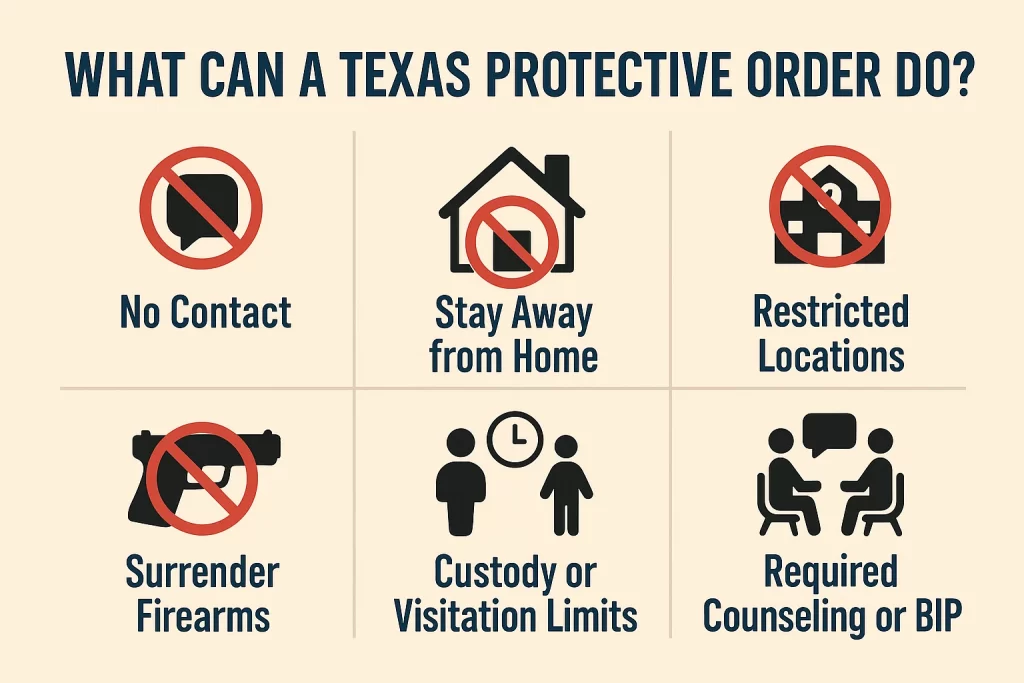Protective orders in Texas are civil court orders designed to prevent further harm in cases involving family violence, dating violence, stalking, sexual assault, or human trafficking. Though civil in nature, they carry significant legal and criminal consequences if violated.
The legal framework for protective orders is primarily set forth in the Texas Family Code, with related enforcement provisions in the Penal Code and Code of Criminal Procedure.
Protective orders in Texas are not limited to spouses or family members. Under the Texas Family Code, individuals in a dating relationship—including girlfriends or boyfriends—may qualify for protection. The law also extends eligibility to former dating partners. This ensures that legal protections are accessible to people in non-marital relationships who face threats or abuse.

Legal Basis and Eligibility
A protective order may be granted when a court finds that family violence has occurred and is likely to occur again.1 “Family violence” includes physical harm, bodily injury, assault, or a credible threat thereof.2 Protective orders are also available in stalking or sexual abuse cases even when the parties have no familial or dating relationship.3
Eligible applicants include victims themselves, as well as parents or guardians acting on behalf of minors, prosecutors, and representatives of the Department of Family and Protective Services.4
Common Scenarios
Protective orders are frequently issued in situations such as:
- Domestic violence between spouses or intimate partners
- Abuse by a parent or relative against a child or vulnerable adult
- Stalking or repeated harassment by acquaintances or strangers
- Threats or assaults by former dating partners
- Sexual assault or trafficking
Many applications are initiated after an incident that resulted in police involvement, but a criminal arrest is not required.
Types of Protective Orders
Texas law provides for three main types of protective orders:
- Temporary Ex Parte Protective Order: Short-term, emergency order granted without the respondent’s presence. It may last up to 20 days and be extended upon motion.5
- Final Protective Order: Issued after a hearing with both parties present. These orders are generally valid for up to two years but may be extended or made permanent in cases involving serious bodily injury or repeated violations.6
- Magistrate’s Order for Emergency Protection (MOEP): Automatically available after an arrest for family violence, sexual assault, or use of a deadly weapon. Valid for 31 to 91 days depending on the offense.7
Relief Granted
A protective order may contain a wide range of restrictions. Courts may:
- Prohibit any form of contact with the protected person
- Require the respondent to vacate a shared residence
- Restrict access to the protected person’s workplace, school, or church
- Mandate participation in counseling or batterer intervention programs
- Order the surrender of firearms
- Impose child custody or visitation limits8
If children are involved, the order may modify or override existing custody arrangements under Title 5 of the Family Code.
Procedure and Burden of Proof
An applicant must file in a court in a county in which the family violence is alleged to have occurred, or the county where either party resides.9 The burden of proof is a preponderance of the evidence for a final order. Evidence might include police or medical reports, sworn affidavits, witness testimony, text messages, voicemails, or photographs.
Temporary ex parte orders require only a showing of “clear and present danger.”10
Firearm Restrictions
Final protective orders typically prohibit the respondent from possessing firearms. The court may explicitly require surrender of all firearms and prohibit acquisition of new ones.11 This restriction also triggers federal firearm prohibitions under 18 U.S.C. § 922(g)(8).
Enforcement and Penalties
All protective orders are entered into the Texas Crime Information Center (TCIC) and the National Crime Information Center (NCIC), and law enforcement officers are obligated to enforce them statewide.12 Violating a protective order is a Class A misdemeanor for first-time violations, punishable by up to 1 year in jail and/or a $4,000 fine.13 Repeat violations or those involving stalking or assault are a Third-degree felony.14
Child Custody Implications
Courts may include provisions limiting or supervising visitation, restricting parental exchanges, or temporarily altering custody rights. These terms are often coordinated with other family law proceedings but can be enforced independently within a protective order.
Interaction with Shared Locations
Protective orders can restrict access to shared spaces—such as a church or child’s school—if the court finds that the protected person would otherwise face ongoing intimidation, fear, or risk of harm. This includes institutions the respondent also regularly attends.
Nationwide Enforceability
Protective orders issued in Texas are enforceable across all U.S. states and territories under the federal Violence Against Women Act and the Uniform Interstate Enforcement of Domestic Violence Protection Orders Act.15
Disclaimer
This article is for general informational purposes only. It does not constitute legal advice and should not be relied upon as a substitute for consultation with a qualified attorney. Laws may change, and each case involves unique facts.
Statutory Citations
- Texas Family Code § 85.001 ↩︎
- Texas Family Code § 71.004 ↩︎
- Texas Code of Criminal Procedure § 7A.01 ↩︎
- Texas Family Code § 82.002 ↩︎
- Texas Family Code § 83.002 ↩︎
- Texas Family Code § 85.025 ↩︎
- Texas Code of Criminal Procedure § 17.292 ↩︎
- Texas Family Code §§ 85.021–85.022 ↩︎
- Texas Family Code § 82.003 ↩︎
- Texas Family Code § 83.001 ↩︎
- Texas Family Code § 85.022(b)(6) ↩︎
- Texas Family Code § 86.0011 ↩︎
- Texas Penal Code § 25.07 ↩︎
- Texas Penal Code § 25.072 ↩︎
- Texas Family Code § 88.001 ↩︎
